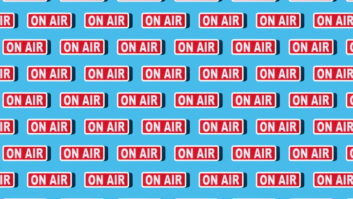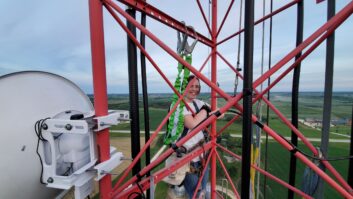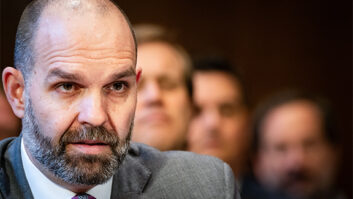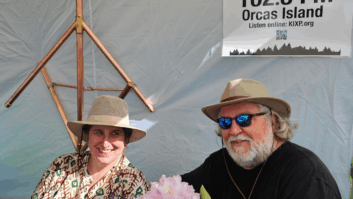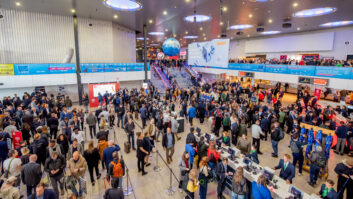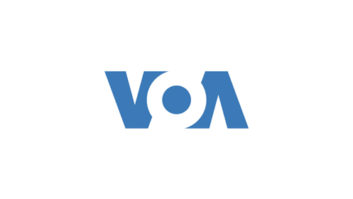One of several articles providing a final overview of news coming out of the April NAB Show.

IBiquity Digital’s Gereon Joachim with two attendees in front of the receiver wall in the tech developer’s booth.
Credit: Photo by Jim Peck
As I reported briefly earlier, Digital PowerRadio’s chief inventor, George Washington University professor Dr. Brana Vojcic, will brief iBiquity Digital engineers in Columbia, Md., about his HD Radio receiver chip technology.
That meeting comes after much “he said/she said” drama leading up to and during the NAB Show.
Representatives of the companies met together with NAB Executive Vice President/Chief Technology Officer Kevin Gage at the convention. Sources said he was trying to figure out what was going on and nudge the parties to talk.
But that too, caused some observers to ask why NAB was even involved in what appears to be a spat between two companies over whether to do business together.
Indeed, the situation is potentially politically sensitive, given that a former FCC chairman and a member of NAB’s executive board are part of the DPR effort.
Subsequently there was another show meeting, without Gage, that included iBiquity President/CEO Bob Struble and General Counsel Al Shuldiner; Digital PowerRadio Chief Inventor Brana Vojcic; its Managing Member Mark Fowler, the former FCC chairman, and his Fowler Radio Group partner Bruce Lederman; and Beasley Broadcast Executive Vice President/Chief Financial Officer Caroline Beasley, who’s a member of the NAB Executive Committee. DPR also met with Commissioner Ajit Pai at the show.
Prior to the convention, Digital PowerRadio laid out its case in coverage on the Radio World website. IBiquity then replied with a guest commentary of its own, saying that what DPR is proposing “doesn’t offer significant improvement” over the HD Radio system now in the field; DPR replied that it stood by its technology.
IBiquity declined comment about the subsequent discussions between the companies for this story.
Sources close to the situation told me after the show that all sides agreed to tone down the public rhetoric; indeed, I heard the word “statesmanship” used.
“We’re trying to address this in a factual way,” said one individual close to the discussions, which is good because a few engineers at the show said to me something along the lines of: “They need to get to the bottom of this.”
The gist of the dispute: DPR claims its technology, parts of which were developed for the cellular phone industry, will make an HD Radio receiver more sensitive and extend the coverage of the AM and FM digital signal, whether it’s all-digital or in the hybrid mode.
Beasley is an investor in DPR. Fowler previously characterized Beasley to me as a “minority” investor in the technology. He said he invested some of his own money too, after being approached by Vojcic a couple of years ago.
When asked to characterize the size of its investment, Caroline Beasley said the broadcast company was not a majority owner but that it takes “any investment” it makes “seriously.” Indeed, the entire Beasley contingent attending the show sat together to hear Vojcic’s BEC presentation.
HD coverage
Asked why the broadcaster invested in DPR, Beasley told me: “We would like to see HD Radio coverage improve.”
IBiquity President/CEO Bob Struble says he agrees with her, and that the company has been implementing improvements to the digital radio system over time. For example, one of those periodic improvements that automakers were interested in for AM included antenna changes, as well as enhancements with the blend back and forth between the digital and analog signals, which I’ve reported.
The company frequently vets ideas to improve the system, both from inside and outside the company, Struble told me earlier. Typically what’s proposed is not cost-effective, won’t work with its technology or both.
DPR wants iBiquity to release its receiver chip source code to a third party, one of the chipmakers that manufacture HD Radio chips, for testing. Only a limited number of people would handle the code and it would be destroyed after the testing to protect iBiquity’s intellectual property, DPR has told me.
Fowler previously told me one chip maker is “very interested” in testing and potentially could get updated HD Radio receiver chips out in 2014. Manufacturers of HD Radio chips include Intel, NXP, Silicon Labs, STMicroelectronics and Texas Instruments.
I asked Vojcic early in the show whether implementing the new chip would make HD Radio receivers in the field obsolete; he said it depended on how the manufacturer implemented the change.
The point of testing would be to validate DPR’s claims of coverage improvement and subject them to peer review.
There was no agreement regarding sharing of the source code in April. Indeed, several engineers I spoke with don’t anticipate that happening.
DPR discussed its technology with the NAB Radio Technology committee earlier in the year and with the National Radio Systems Committee at the show. The standards-setting NRSC is not involved in the dispute.
One source described the upcoming meeting, which will likely happen in May, as a “good first step.”
Aspects of the DPR technology were developed previously with the wireless industry in mind; DPR officials believe if not used in digital radio, other industries could be interested in their technology. “We have one major TV group that has approached us. If we can’t do a deal here, we have other ways to go,” one source told me.
I’ve heard other radio groups were asked to invest as well. A source close to the talks confirms two other groups were asked and declined to invest. “They blew us off,” said the individual, thinking the groups, whom he declined to name, either didn’t understand the DPR technology or didn’t want to “deal with it.”

